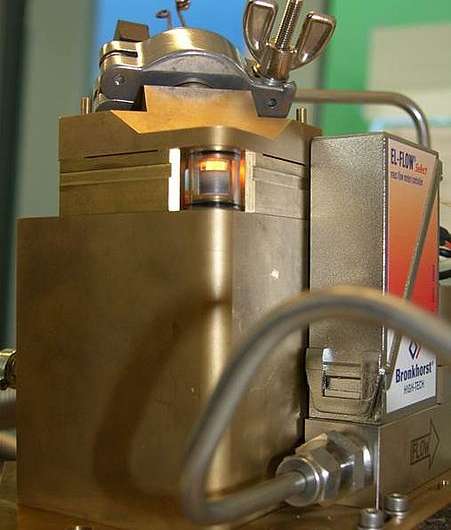Researchers gain a better understanding of the transformation of steel

Heating iron can alter its structure and is one of the methods for making various types of steel with different properties. That process is similar to the formation of frost flowers: one iron crystal structure transforms into another at a nucleus point, and the process expands further from that point. This type of nucleation in materials has the largest impact on their final properties, but is still the least understood in the field of metallurgy. For example, we still know little about how and where exactly this nucleation starts. Researchers at TU Delft have now shed new light on this subject in their publication 'Preferential Nucleation during Polymorphic Transformations' in Scientific Reports (Nature) of Wednesday 3 August.
The researchers demonstrated this nucleation process live by heating an iron sample to 1,000 degrees in a specially produced furnace at the European Synchrotron Radiation Facility in Grenoble, and monitoring the transformation process using X-rays. In this way, they were able to identify the places and their properties that were the most likely starting points for the nucleation process of the transition from ferrite to austenite.
Alloys
Up until now, the most widely used method for changing the properties of steel is the addition of elements affecting the structure, and therefore the properties, of the resulting steel type: alloys. Alloys can consist of more than ten different types of elements, making both manufacturing them and recycling them complicated and often expensive.
Microstructure
Insight into the nucleation process may yield a solution. If you could direct this process, you would theoretically be able to create microstructures that give the material the desired macroscopic properties, without the addition of other (rare) elements. TU Delft materials scientist Erik Offerman: 'Steel must be both strong and sufficiently deformable in order to, for example, make components lighter in the automotive industry. When manufacturing so-called electrical steel for transformer cores and fire-resistant steels for high-rise buildings, you are also looking for specific properties. The nucleation process is the key to limiting the use of alloying elements in these processes. We have now found places where an iron crystal tends to nucleate.'
Simple bulk metals
Offerman: 'If you can make metals less complex – i.e. use less alloying elements and do more with the microstructure – you can also keep the bulk metals simpler. That would make production less expensive, and it would also make it easier to reuse the metals when recycling a mixture of different steel grades, because they will have the same or similar composition. You would therefore have to experiment more with the structure than with the alloying. The next step is to replace critical alloying elements in metals and to reduce the number of different alloying elements and the concentration of the alloying elements by optimising the microstructure'
The long run
Offerman already formulated a hypothesis on the activation energy of the nucleation process fourteen years ago, which was harshly criticised by one of the experts in the field at that time. With this article, he was finally able to prove his hypothesis.
More information: H. Sharma et al. Preferential Nucleation during Polymorphic Transformations, Scientific Reports (2016). DOI: 10.1038/srep30860
Journal information: Scientific Reports , Nature
Provided by Delft University of Technology



















